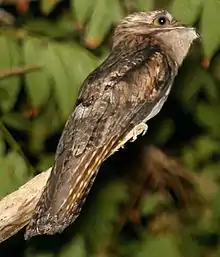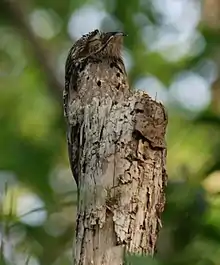Potoo
Potoos (family Nyctibiidae) are a group of Caprimulgiformes birds related to the nightjars and frogmouths. They are sometimes called poor-me-ones, after their haunting calls. There are seven species in one genus, Nyctibius, in tropical Central and South America.
| Potoo | |
|---|---|
 | |
| Northern potoo (Nyctibius jamaicensis) | |
| Scientific classification | |
| Kingdom: | Animalia |
| Phylum: | Chordata |
| Class: | Aves |
| Order: | Caprimulgiformes |
| Family: | Nyctibiidae Chenu & des Murs, 1851 |
| Genus: | Nyctibius Vieillot, 1816 |
| Species | |
|
See text | |
 | |
| Global range (In red) | |
These are nocturnal insectivores which lack the bristles around the mouth found in the true nightjars. They hunt from a perch like a shrike or flycatcher. During the day they perch upright on tree stumps, camouflaged to look like part of the stump. The single spotted egg is laid directly on the top of a stump.
Evolution and taxonomy

The potoos are today an exclusively New World family, but they apparently had a much more widespread distribution in the past. Fossil remains of potoos dating from the Oligocene and Eocene have been found in France and Germany.[1] A complete skeleton of the genus Paraprefica has been found in Messel, Germany. It had skull and leg features similar to those of modern potoos, suggesting that it may be an early close relative of the modern potoos. Because the only fossils other than these ancient ones that have been found are recent ones of extinct species, it is unknown if the family once had a global distribution which has contracted, or if the distribution of the family was originally restricted to the Old World and has shifted to the New World.[1]
A 1996 study of the mitochondrial DNA of the potoos supported the monophyly of the family although it did not support the previous assumption that it was closely related to the oilbirds.[2] The study also found a great deal of genetic divergence between the species, suggesting that these species are themselves very old. The level of divergence is the highest of any genus of birds, being more typical of the divergence between genera or even families. This raises the possibility that there are several cryptic species to be discovered. For example, the northern potoo was for a long time considered to be the same species as the common potoo, but the two species have now been separated on the basis of their calls. In spite of this there is no morphological way to separate the two species.[3]
Morphology
The potoos are a highly conservative family in appearance, with all the species closely resembling one another; species accounts in ornithological literature remark on their unusual appearance.[3] Potoos range from 21 to 58 cm in length. They resemble upright sitting nightjars, a closely related family (Caprimulgidae). They also resemble the frogmouths of Australasia, that are stockier and have much heavier bills. They have proportionally large heads for their body size and long wings and tails. The large head is dominated by a massive broad bill and enormous eyes. In the treatment of the family in the Handbook of the Birds of the World, Cohn-Haft describes the potoos as "little more than a flying mouth and eyes".[3] The bill, while large and broad, is also short, barely projecting past the face. It is delicate, but has a unique "tooth" on the cutting edge of the upper mandible that may assist in foraging. Unlike the closely related nightjars, the potoos lack rictal bristles around the mouth. The legs and feet are weak and used only for perching.
The eyes are large, even larger than those of nightjars. As in many species of nocturnal birds, they reflect the light of flashlights.[4] Their eyes, which could be conspicuous to potential predators during the day, have unusual slits in the lids,[5] which allow potoos to sense movement even when their eyes are closed. Their plumage is cryptic, helping them blend into the branches on which they spend their days.
Habitat and distribution
The potoos have a Neotropical distribution.[3] They range from Mexico to Argentina, with the greatest diversity occurring in the Amazon Basin, which holds five species. They are found in every Central and South American country. They also occur on three Caribbean islands: Jamaica, Hispaniola and Tobago. The potoos are generally highly sedentary, although there are occasional reports of vagrants, particularly species that have travelled on ships. All species occur in humid forests, although a few species also occur in drier forests.
Behavior

The potoos are highly nocturnal and generally do not fly during the day. They spend the day perched on branches with the eyes half closed. With their cryptic plumage they resemble stumps, and should they detect potential danger they adopt a "freeze" position which even more closely resembles a broken branch.[6][7] The transition between perching and the freeze position is gradual and hardly perceptible to the observer.
The English zoologist Hugh Cott, describing Nyctibius griseus as "this wonderful bird", writes that it "habitually selects the top of an upright stump as a receptacle for its egg, which usually occupies a small hollow just, and only just, large enough to contain it ... the stump selected had thrown up a new leader just below the point of fracture ... and the birds sat facing this in such a way that when viewed from behind they came into line and blended with the grey stem."[8]
Diet and feeding
Potoos feed at dusk and at night on flying insects.[3] Their typical foraging technique is to perch on a branch and occasionally fly out in the manner of a flycatcher in order to snatch a passing insect. They occasionally fly to vegetation to glean an insect off it before returning to their perch, but they do not attempt to obtain prey from the ground. Beetles form a large part of their diet, but they also take moths, grasshoppers and termites. One northern potoo was found with a small bird in its stomach as well. Having caught an insect, potoos swallow it whole without beating or crushing it.
Breeding
Potoos are monogamous breeders and both parents share responsibilities for incubating the egg and raising the chick. The family does not construct a nest of any kind, instead laying the single egg on a depression in a branch or at the top of a rotten stump. The egg is white with purple-brown spots. One parent, often the male, incubates the egg during the day, then the duties are shared during the night. Changeovers to relieve incubating parents and feed chicks are infrequent to minimise attention to the nest, as potoos are entirely reliant on camouflage to protect themselves and their nesting site from predators. The chick hatches about one month after laying and the nestling phase is two months, a considerable length of time for a landbird. The plumage of nestling potoos is white and once they are too large to hide under their parents they adopt the same freeze position as their parents, resembling clumps of fungus.
Defense
Mobbing behavior has also been observed among common potoos (Nyctibius griseus). Avian mobbing is a widespread behavior in which an individual or a group of birds deliberately confronts a potential predator. Mobbing birds crowd around the predator, approaching and retreating, sometimes even chasing and attacking the predator. They also emit loud repeated calls, which generally attract additional birds of other species to join in the mobbing.
The behaviors described above suggest that the common potoo adopts different defensive strategies to suit its circumstances. For a lone potoo, or a brooding adult with a potential predator close to the nest, the bird attempts to avoid detection by remaining motionless and relying on camouflage. If ineffective, the potoo, breaks cover and attempts to intimidate the predator by opening its beak and eyes wide open while vocalizing or simply flies out of reach. Nocturnal predators rely less on vision for locating prey therefore a different strategy may be required at night.[9]
Species
| Phylogeny of Nyctibiidae[10] | |||||||||||||||||||||||||||||||||||||||
|
Genus Nyctibius Vieillot 1816[11]
- Rufous potoo, Nyctibius bracteatus Gould 1846
- Great potoo, Nyctibius grandis (Gmelin 1789)
- Long-tailed potoo, Nyctibius aethereus (zu Wied-Neuwied 1820)
- N. a. aethereus (zu Wied-Neuwied 1820) (Large-tailed Potoo)
- N. a. chocoensis Chapman 1921
- N. a. longicaudatus (von Spix 1825) (Long-tailed Potoo)
- White-winged potoo, Nyctibius leucopterus (zu Wied-Neuwied 1821)
- Andean potoo, Nyctibius maculosus Ridgway 1912
- Common potoo or lesser potoo, Nyctibius griseus (Gmelin 1789)
- N. g. griseus (Gmelin 1789) (Grey Potoo)
- N. g. panamensis Ridgway 1912
- Northern potoo, Nyctibius jamaicensis (Gmelin 1789)
- N. j. jamaicensis subspecies-group
- N. j. abbotti Richmond 1917 (Hispaniolan Potoo)
- N. j. jamaicensis (Gmelin 1789) (Jamaica Potoo)
- N. j. mexicanus subspecies-group
- N. j. costaricensis Ridgway 1912 (Central American common potoo)
- N. j. lambi Davis 1959
- N. j. mexicanus Nelson 1900 (Mexican common potoo)
- N. j. jamaicensis subspecies-group
References
- Mayr, G (2005). "The Palaeogene Old World Potoo Paraprefica Mayr, 1999 (Aves, Nyctibiidae): its osteology and affinities to the New World Preficinae Olson, 1987". Journal of Systematic Palaeontology. 3 (4): 359–370. doi:10.1017/S1477201905001653.
- Mariaux, Jean & Braun, Michael J. (1996). "A Molecular Phylogenetic Survey of the Nightjars and Allies (Caprimulgiformes) with Special Emphasis on the Potoos (Nyctibiidae)". Molecular Phylogenetics and Evolution. 6 (2): 228–244. doi:10.1006/mpev.1996.0073. PMID 8899725.
- Cohn-Haft, M (1999) "Family Nyctibiidae (Potoos)". in del Hoyo, J.; Elliot, A. & Sargatal, J. (eds). Handbook of the Birds of the World. Volume 5: Barn-Owls to Hummingbirds. Lynx Editions. pp. 288–297 ISBN 84-87334-25-3
- Van Rossem, A (1927). "Eye Shine in Birds, with Notes on the Feeding Habits of Some Goatsuckers" (PDF). The Condor. 29 (1): 25–28. doi:10.2307/1363006. JSTOR 1363006.
- Borrero, J (1974). "Notes on the Structure of the Upper Eyelid of Potoos (Nyctibius)" (PDF). The Condor. 76 (2): 210–211. doi:10.2307/1366732. JSTOR 1366732.
- Perry, D (1979). "The Great Potoo in Costa Rica" (PDF). The Condor. 81 (3): 320–321. doi:10.2307/1367649. JSTOR 1367649.
- Attenborough, D. 1998 The Life of Birds. BBC ISBN 0563-38792-0
- Cott, Hugh. 1940. Adaptive Coloration in Animals. Oxford University Press. pp. 352–353. See Hugh Cott for his drawing of a 'Poor-me-one'.
- Common Potoo: Cornell Lab of Ornithology
- Boyd, John (2007). "STRISORES II- Apodiformes". John Boyd's website. Retrieved 30 December 2017.
- "Comparison of IOC 8.1 with other world lists". IOC World Bird List. v8.1. Retrieved 30 December 2017.
- Cestari, C., Guaraldo, A., & Gussoni, C (n.d.). Nesting behavior and parental care of common potoo (Nyctibius griseus) in southern Brazil. The Wilson journal of ornithology, 102-106
- Meek, K. (n.d.) Mobbing. Mobbing, 1-12
External links
- Potoo videos on the Internet Bird Collection